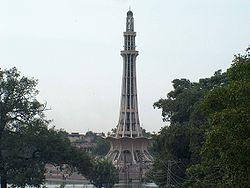Minar-e-Pakistan
| Minar-e-Pakistan | |
|---|---|
| File:Minar-e-Pakistan, Lahore.jpg | |
 | |
| General information | |
| Status | National Tower of Pakistan |
| Location | Lahore, Pakistan |
| Height | |
| Roof | 62 metres (203 ft) |
| Design and construction | |
| Architect(s) | Naseer-ud-din Murat Khan |
Minar-e-Pakistan is a tall minaret in Iqbal Park Lahore, built in commemoration of the Lahore Resolution. The minaret reflects a blend of Mughal and modern architecture, and is constructed on the site where on March 23, 1940, seven years before the formation of Pakistan, the Muslim League passed the Lahore Resolution (Qarardad-e-Lahore), demanding the creation of Pakistan.[1] This was the first official declaration to establish a separate homeland for the Muslims living in the South Asia.[2] Pakistan now celebrates this day as a national holiday each year.
The monument attracts visitors from all over Pakistan, as well as the inhabitants of the Walled City of Lahore. The large public space around the monument is commonly used for political and public meetings, whereas Iqbal Park area is popular among kite-flyers.
Design
The tower was designed by Naseer-ud-Deen Murat Khan a Pakistani architect of (Daghestan) Russian descent,and structural engineer was Abdur Rahman Khan Niazi . The foundation stone was laid on March 23, 1960. The construction took eight years of time, and was completed in 1968 at a cost of PKR 500,000. Today, the minaret provides a panoramic view to visitors who can climb up the stairs or through an Elevator. The parks around the monument include marble fountains and an artificial lake.
Structure
The base is about 8 meters above the ground. The tower rises about 60 meters on the base, thus the total height of minaret is about 72 meters above the ground. The unfolding petals of the flower-like base are 9 meters high. The diameter of the tower is about 97.5 meters (320 feet). The base platform is shaped like a five-pointed star and encloses two crescent shaped pools. There is a central spiral staircase rising up with 162 steps. The top-dome of the minaret is made of Stainless steel inlaid with fine glass pieces.
The structure is made of reinforced concrete, stones, and marble. The rostrum is built of patterned tiles, and faces the Badshahi Mosque. The base comprises four platforms. To symbolise humble beginnings of the freedom struggle, first platform is built with uncut Taxila stones, second platform is made of hammer-dressed stones, whereas third platform is of chiselled stones. Polished white marble at the fourth and final platform depicts the success of the Pakistan Movement.[3] Mr. Mukhtar Masood a prolific writer and the then deputy commissioner of Lahore was responsible for the construction of this monument.
Inscriptions

At the base, there are floral inscriptions on ten converging white marble Commemorative plaques. The incriptions include the text of Lahore Resolution in Urdu, Bengali and English, and Delhi Resolution’s text, which was passed on April 9, 1946. On different plaques, Quranic verses and 99 attributes of God are inscribed in Arabic calligraphy, whereas National Anthem of Pakistan in Urdu and Bengali, excerpts from the speeches of Muhammad Ali Jinnah, in Urdu, Bengali and English, as well as few couplets of Allama Iqbal are inscribed.[3]
Environmental concerns
With the growth of the city and location of the monument at busy intersection of Circular Road and Multan Road, air pollution from traffic-congestion is continuously damaging the marble structure which is now in need of refurbishment.
References
- ^ Christophe Jaffrelot (2002) A History of Pakistan and Its Origins. Athens Press. 326 pages. ISBN 1843311496
- ^ Ian Talbot (1998) Pakistan: A Modern History. St. Martin's Press. 450 pages. ISBN 0312216068
- ^ a b Amna Jamal (2002) The Pakistan Day memorial. DAWN. 23 March. Retrieved on 12 February, 2008
See also
External links
- http://archnet.org/library/sites/one-site.tcl?site_id=364
- http://www.lahore.com/content/section/4/45/
- View from space (Google Maps)
